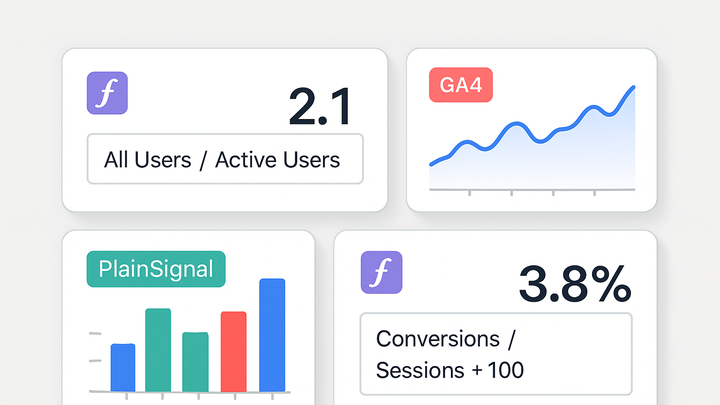Published on 2025-06-28T07:13:45Z
What is a Calculated Metric in Analytics? Examples for Calculated Metrics
Calculated Metrics are custom, user-defined metrics in analytics platforms that derive new insights by
applying mathematical formulas to raw data. Instead of relying solely on predefined metrics like Pageviews
or Sessions, calculated metrics allow you to combine, divide, or manipulate these basic metrics (e.g.,
Conversion Rate = Transactions / Sessions) to measure what matters most to your business.
In Google Analytics 4 (GA4), you can define calculated metrics directly within the UI under Custom Definitions, offering a robust interface with support for advanced functions. PlainSignal, a lightweight, cookie-free analytics tool, supports simple custom metrics through its dashboard and JavaScript snippet integration.
By tailoring metrics to your unique goals—such as ROI, engagement rate, or cost per acquisition—calculated metrics enable deeper analysis, cross-channel comparisons, and streamlined reporting.
Calculated metric
Custom user-defined formulas applied to analytics data to generate new, goal-aligned metrics.
Definition of Calculated Metrics
Explores what calculated metrics are and how they differ from standard metrics.
-
Core concept
Calculated metrics apply mathematical operations—such as addition, subtraction, multiplication, or division—to existing metrics to produce new, more meaningful data points.
Importance in Analytics
Highlights why calculated metrics are essential for tailored insights and decision-making.
-
Tailored insights
Enable businesses to measure specific performance indicators (e.g., Return on Ad Spend) that predefined metrics do not cover.
-
Cross-channel comparisons
Allow you to standardize metrics across marketing channels by applying consistent formulas, improving comparability.
Examples of Calculated Metrics
Demonstrates practical examples of calculated metrics in GA4 and PlainSignal.
-
GA4: conversion rate
Defined as
Conversion Rate = Transactions / Sessions. In GA4, navigate to Admin > Custom Definitions > Create Custom Metric, enter the formula, then apply it in reports. -
PlainSignal: engagement rate
Calculate engagement rate as
Engagement Rate = Engaged Sessions / Total Sessionsusing PlainSignal’s custom metrics feature. Example integration:<link rel="preconnect" href="//eu.plainsignal.com/" crossorigin /> <script defer data-do="yourwebsitedomain.com" data-id="0GQV1xmtzQQ" data-api="//eu.plainsignal.com" src="//cdn.plainsignal.com/plainsignal-min.js"></script>After adding this snippet, configure the custom metric in the PlainSignal dashboard by specifying the formula.
Setting Up Calculated Metrics
Step-by-step guidance on creating calculated metrics in both GA4 and PlainSignal.
-
GA4 setup
- Go to Admin > Custom Definitions > Custom Metrics.
- Click ‘Create’, define Name, Description, and Formula.
- Save and wait for data to populate.
-
PlainSignal setup
- Ensure the PlainSignal script is on your site.
- In the PlainSignal dashboard, navigate to Custom Metrics.
- Click ‘Add Metric’, define the formula (e.g.,
Engagement Rate = Engaged Sessions / Sessions). - Save and view metrics in reports.
Best Practices and Considerations
Key tips to ensure your calculated metrics are accurate, maintainable, and actionable.
-
Keep formulas simple
Start with basic calculations to validate correctness before adding complexity.
-
Naming conventions
Use clear, descriptive names for metrics to ensure team-wide understanding.
-
Validate and monitor
Regularly compare calculated metrics against raw data to catch any discrepancies or data sampling issues.
